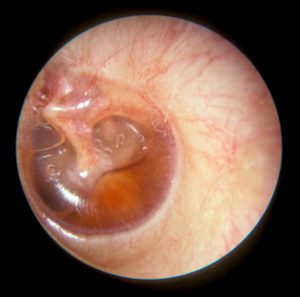Middle Ear Effusion
Middle ear effusion or fluid in the middle ear is a very common condition occur in children. Parents might be complaining of their children could not heard well and problem of learning in the school. However, the hearing loss is usually mild and there is no other associated symptoms present.

Otitis media with effusion is usually due to nasal problem which affects the eustachian tube
Otitis media with effusion usually due to Eustachian dysfunction which is very common in children especially after an episode of upper respiratory tract infection (URTI). Besides, patient with cleft palate and down’s syndrome might experienced chronic non resolving middle ear effusion due to the abnormal anatomical structure and physiological function of their Eustachian tube.
Other chronic nasal diseases might also contribute to the occurrence of middle ear effusion in children such as allergic rhinitis, rhinosinusitis and also adenoid hypertrophy.
Meanwhile middle ear effusion in adult is less common and more investigation have to be done in adult to rule out any sinister diseases such as nasopharyngeal carcinoma, sinonasal carcinoma or lymphoma which might occur in the nasopharynx. Besides that, rhinosinusitis, allergic rhinitis and URTI might also cause the similar problem. Post radiation or operation of nasopharyngectomy might also cause chronic middle ear effusion. Adult with middle ear effusion might complaint of ear discomfort, tinnitus or ringing sound, reduced hearing and even ear fullness.
Treatment of the otitis media with effusion is mainly treating the nose as the cause of the otitis media in this condition is due to the Eustachian tube dysfunction. Intranasal and oral decongestant and intranasal steroid usually will help in the acute condition. However, in chronic Eustachian dysfunction where the effusion is persistent even after adequate medical therapy, then it might warrants a surgical intervention. Effusion could be drained and ventilation of the middle ear could be improved with a small procedure where a small hole is made over the ear drum and a small ventilation tube being inserted to keep the ear drum open. This will help to improved the ventilation of the middle ear and prevent effusion from being form. The ventilation tube (grommet) will dropped out by itself after 3 – 6 months period. Intraoperatively or prior to the operation, the adenoid should be examined to exclude the possible cause of eustachian tube dysfunction. Adenoid enlargement or hypertrophic adenoid might cause the blockage of the Eustachian tube. Adenoid might need to be removed during the same setting if it is noted to be the cause.
There are cases where post extrusion of grommet, effusion recurred when the ear drum healed. In cases where the effusion recurred and noted the Eustachian tube dysfuntion to be irreversible, a long term ventilation tube (T-tube) could be inserted.
The function of the ventilation tube not only to ventilate the middle ear, its also help in equalizing the pressure between the external environment and the middle ear. In untreated eustachian tube dysfunction and effusion of middle ear may progress to retraction of the ear drum and this may cause worsening of hearing and it might cause cholesteatoma in long term.